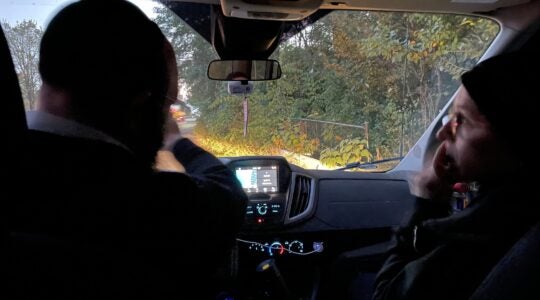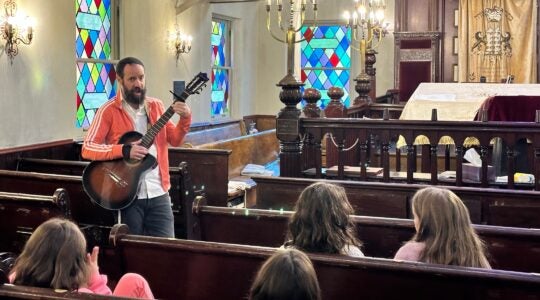There once was a time when having a dog was considered the height of goyish culture, something for non-Jews only. But now? It’s totally Yiddish.
At least that’s according to a new event from the Workmen’s Circle, the historically Yiddish socialist organization, which is now appealing to a new crowd with its sporadic Yiddish for Dogs class in Central Park. This was the third class where the dogs of New York have learned to zitz (sit), shtai (stay), kum (come) and shpring (jump) while their owners connected to Yiddish culture in a new way.
“It’s a wonderful experience for us to connect with our dogs and each other and our heritage,” said Ann Toback, executive director of the Workmen’s Circle. “It’s fun, the dogs respond to you and then people around you respond to the language.”
Based on the array of New Yorkers in attendance Sunday morning, some with dogs and some without, the approach seems to be working. Steven Zelman and his dog, Ollie, easily picked up the new Yiddish commands. While participants assembled and snacked on black-and-white cookies and coffee cake, Zellman joked that the event was part of his dog’s bar mitzvah preparations. “He’s 12 years old so he’s going to be bar mitzvahed next year,” said Zelman, who lives on the East Side of Manhattan. “He barks ok in Yiddish but he can’t read it so I hope he’ll learn a little bit.”
Debbie Kross, whose dog came from a shelter, said he “had his own opinion about things,” so she didn’t expect him to pick up much Yiddish from the event. “We speak French at home–he doesn’t listen to that either,” she said. “If he takes anything from today, that’s good, and if not we’ll just have fun.”
It turns out that most of the dogs really do respond. Miguel Rodriguez, the dog trainer who ran this week’s event, said that dogs respond to Yiddish better than English because the language is “sharper.” “Dogs don’t necessarily remember vocabulary, they remember tones,” said Rodriguez, who has trained dogs in Schutzhund, a German protection dog training method. He said the similarities between Yiddish and German made the language especially useful in dog training. “The tones in Yiddish are sharper so it sticks with dogs a little more easily,” he said.
Leyzer Burko, a Yiddishist who taught the Yiddish commands, noted that Jews and dogs historically did not mix. “In traditional Jewish culture, dogs had no place, dogs were goyish,” said Burko. “I looked through the Yiddish thesaurus to look for expressions for dogs, and they’re all negative, one-hundred percent. There are no positive expressions about dogs in Yiddish.”
But in true Jewish fashion, there was disagreement about the traditional Jewish view of dogs. Robert Friedman, who lives on the Upper West Side and brought his two elementary school-aged sons to watch, disagreed with Burko’s assessment. According to the Talmud, on the night the Jews left Egypt and escaped slavery, the dogs in Egypt were quiet and enabled the Jews to escape without notice. That is why, Friedman said, the rabbis said that chametz, the leavened food that is forbidden on Passover, should be given to the dogs to eat. “The idea is that there isn’t a total antipathy towards dogs,” said Friedman.
Still, for the majority of the remaining Yiddish-speaking communities, which are almost entirely ultra-Orthodox, dogs are an uncommon sight. “This event would not occur in Borough Park or Williamsburg,” said Burko. But he noted that the strange combination of Yiddish and dogs might be the reason the class has drawn so many participants — and so much media attention. “The event itself is absurd, like I said Yiddish and dogs don’t mix traditionally, so it doesn’t make any sense,” said Burko. “That being said, it’s kind of wonderful.”
The New York Jewish Week brings you the stories behind the headlines, keeping you connected to Jewish life in New York. Help sustain the reporting you trust by donating today.




